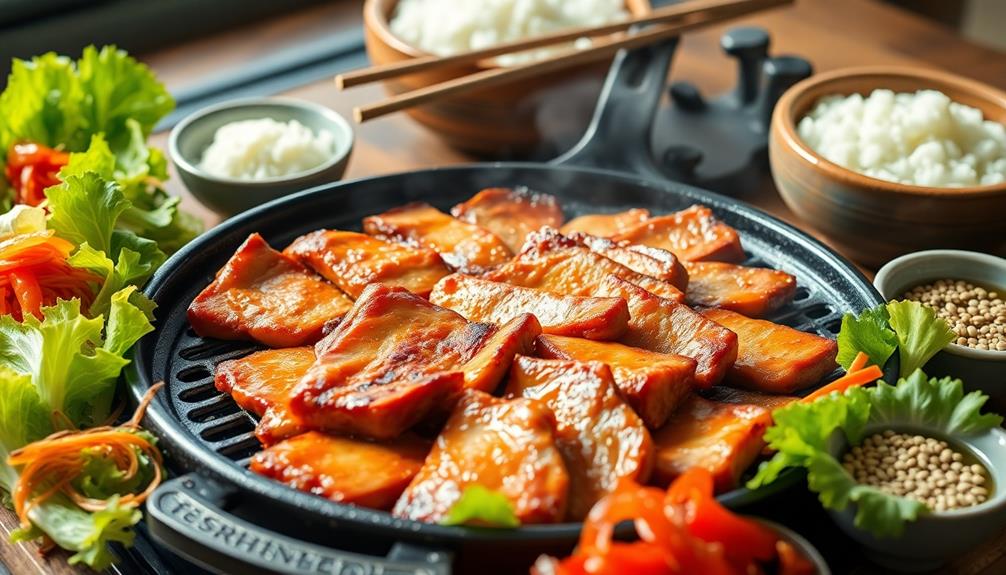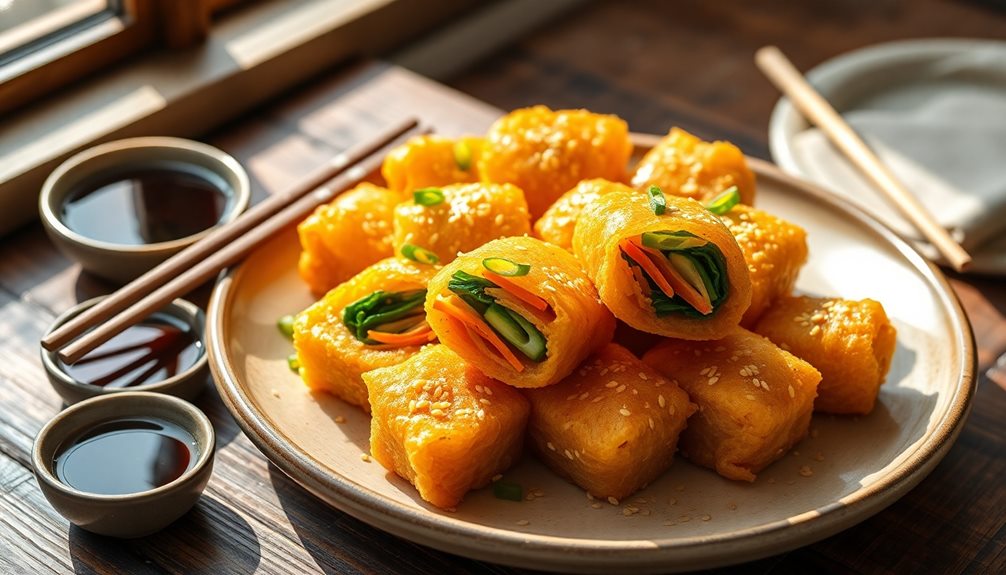Samgyeopsal, or grilled pork belly, is a tasty Korean dish that's all about sharing and having fun! You'll start with thick slices of pork belly, marinate them in sesame oil, and grill them until crispy and golden. The best part? You get to dip each bite in ssamjang sauce, a mix that's super flavorful! Don't forget to add crunchy veggies like lettuce and cucumbers for that extra oomph. This dish is perfect for gatherings, as everyone can enjoy cooking and chatting together. It's a delightful experience, and there's so much more to explore about it!
Key Takeaways
- Samgyeopsal is a popular Korean dish featuring grilled pork belly, known for its rich flavor and cultural significance in communal dining experiences.
- The dish is traditionally prepared by grilling thick, well-marbled pork belly slices at the table, enhancing interaction among diners.
- Essential ingredients include high-quality pork belly, sesame oil for marinating, and ssamjang sauce for dipping, complemented by fresh vegetables.
- Cooking involves grilling the pork for 4-5 minutes on each side for a crispy exterior while retaining juiciness.
- Diners enjoy samgyeopsal by wrapping grilled pork in lettuce with vegetables and dipping it in flavorful sauces for a complete bite.
History
Samgyeopsal, the beloved Korean grilled pork belly, has roots that stretch back centuries. This tasty dish is a favorite among many people, and it's easy to see why! It started gaining popularity in Korea during the 20th century, particularly after the Korean War. Back then, folks needed hearty meals, and what better way than grilling delicious pork belly right at the table?
You'll find that samgyeopsal isn't just about the meat; it's a whole experience! Families and friends gather around a grill, cooking together and sharing laughter. Isn't that wonderful? The sizzling sound of pork belly cooking and the mouthwatering aroma fill the air, making everyone's stomach rumble in excitement!
Traditionally, diners enjoy samgyeopsal with various sides, like fresh vegetables and spicy sauces. This way, you can create your own tasty bites, rolling the grilled pork in lettuce leaves or dipping it into savory sauces.
Plus, it's a great way to be social while enjoying a delicious meal! So, next time you're at a Korean barbecue, remember the rich history behind this scrumptious dish, and savor every bite of that juicy, grilled goodness!
Recipe
Samgyeopsal, a beloved Korean barbecue dish, features thick slices of pork belly grilled to perfection. Traditionally enjoyed in a communal setting, diners grill the meat at the table and pair it with a variety of sides and condiments. The rich, savory flavor of the pork belly, combined with the freshness of vegetables and the heat of dipping sauces, creates an unforgettable dining experience that has gained popularity beyond Korea.
To prepare samgyeopsal at home, the key is to use high-quality pork belly, which has a perfect balance of fat and meat. While grilling the pork, it's important to pay attention to the cooking time to achieve the ideal crispy exterior while keeping the inside juicy and tender.
Serve the grilled pork with fresh lettuce leaves, garlic, and a selection of dipping sauces, allowing each guest to customize their own bites.
Ingredients:
- 1 pound pork belly (samgyeopsal)
- Lettuce leaves
- Sliced garlic
- Sliced green chili peppers
- Sesame oil
- Salt
- Pepper
- Ssamjang (Korean dipping sauce)
- Gochujang (Korean chili paste)
- Sliced vegetables (optional, e.g., cucumber, carrot)
For cooking, preheat a grill or grill pan over medium-high heat. Season the pork belly slices with a sprinkle of salt and pepper. Place the pork belly on the grill and cook for about 4-5 minutes on each side or until the meat is nicely browned and crispy.
While the pork is grilling, prepare a plate with lettuce leaves and sliced garlic, and arrange your dipping sauces nearby. Once the pork is cooked, slice it into bite-sized pieces and serve with the prepared accompaniments.
Extra Tips: When grilling samgyeopsal, avoid overcrowding the grill to ensure even cooking. If you prefer a smokier flavor, consider using a charcoal grill.
Feel free to experiment with different dipping sauces and sides to enhance the meal. Lastly, remember that samgyeopsal is best enjoyed fresh off the grill, so encourage your guests to partake in the cooking process for a fun and interactive dining experience.
Cooking Steps
Ready to cook up some delicious samgyeopsal?
First, you'll need to prepare those tasty pork belly slices and marinate them with sesame oil to add a burst of flavor.
Once you're all set, grill them until they're crispy brown, and don't forget to serve them with some ssamjang sauce and fresh veggies for that extra crunch!
Step 1. Prepare Pork Belly Slices

To kick off the preparation of pork belly slices, start by selecting high-quality pork belly that's well-marbled for the best flavor and texture. Look for slices that are about half an inch thick, as this thickness helps them cook perfectly.
Once you've got your pork belly, it's time to give it a good rinse under cold water. This helps remove any excess salt or impurities that might be lingering from processing.
Next, pat the slices dry with a paper towel. This step is super important because it prevents steaming when you grill them, ensuring that you get a nice crispy edge.
Now, lay the pork belly slices flat on a cutting board. Don't forget to take a moment to admire that beautiful marbling!
If you want, you can use a sharp knife to score the surface lightly. This little trick helps the fat render out while cooking, making the meat even tastier.
Step 2. Marinate With Sesame Oil
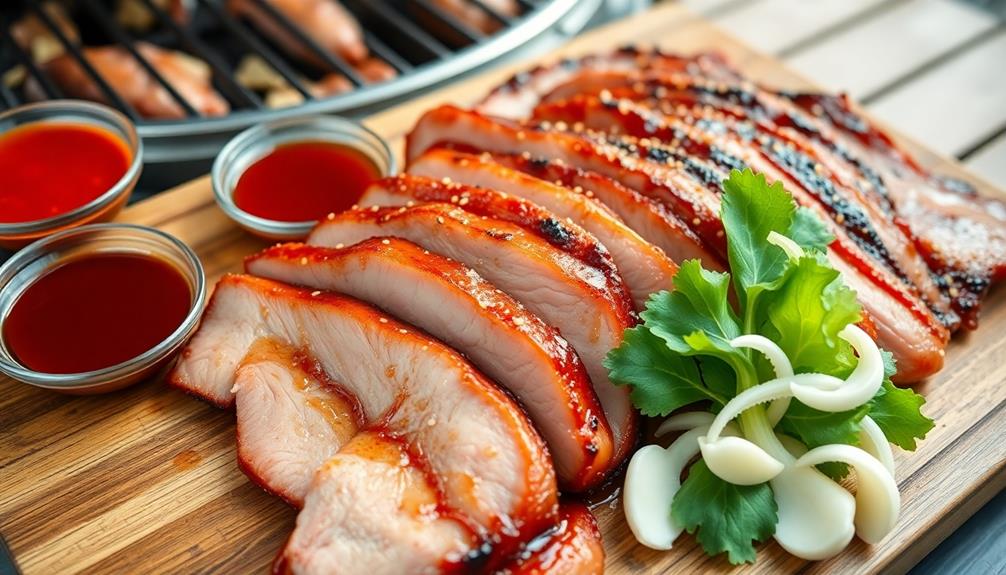
Marinating the pork belly slices in sesame oil adds a rich, nutty flavor that elevates your samgyeopsal experience.
To start, gather your pork belly slices and place them in a bowl. Drizzle a generous amount of sesame oil over the meat—about two tablespoons should do the trick.
Now, here comes the fun part! Use your hands to massage the oil into the pork, making sure every slice gets a good coating. It's like giving your pork a little spa treatment!
Next, you can add a pinch of salt and pepper for extra flavor, but the sesame oil is the star of the show.
Once you've mixed everything well, cover the bowl with plastic wrap or a lid. Let the pork belly marinate in the fridge for at least 30 minutes. If you've got more time, letting it sit for a few hours or even overnight will make the flavors even better—talk about a flavor party!
When you're ready to cook, just remember that the marinated pork belly will be super tasty, so get ready to enjoy a delicious meal. Your taste buds are in for a treat!
Step 3. Grill Until Crispy Brown
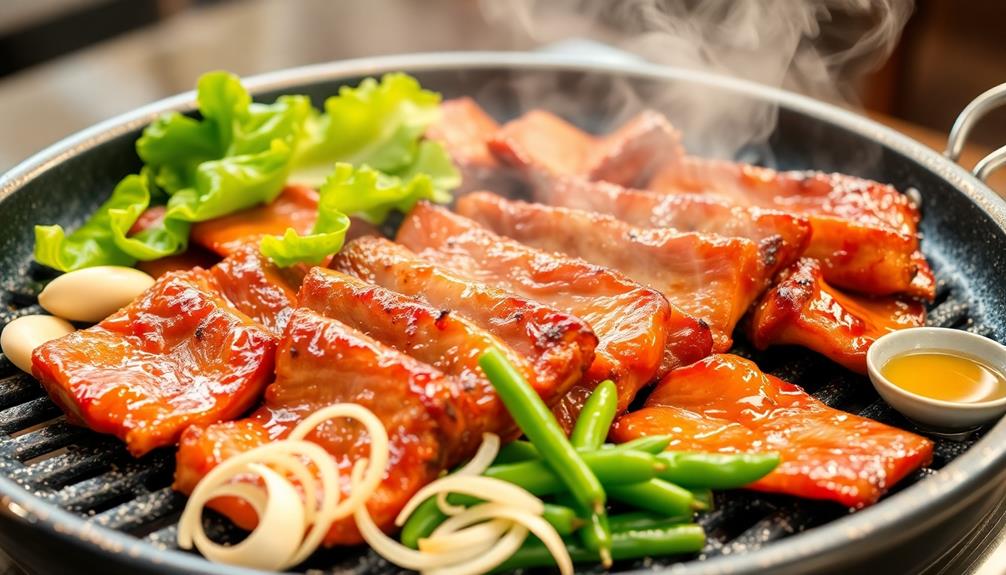
After letting your pork belly marinate, it's time to fire up the grill! Make sure your grill is nice and hot—this helps achieve that perfect crispy brown texture.
Place the marinated pork belly slices on the grill, leaving some space between each piece. You want them to sizzle and not steam!
Cook the pork belly for about 4-5 minutes on one side without moving them. This is when they start to turn golden and crispy.
Flip them over using tongs, and grill the other side for another 4-5 minutes. Keep an eye on them, as you don't want them to burn.
If they start to bubble and pop, that's a good sign! It means the fat is rendering, leading to a delicious crispy finish.
You can even press down gently with a spatula to get extra crunch. Once both sides are beautifully browned, remove the pork belly from the grill.
Let it rest for a minute before slicing it into bite-sized pieces. The aroma will make everyone's mouth water, and you'll be one step closer to enjoying a tasty meal!
Step 4. Serve With Ssamjang Sauce
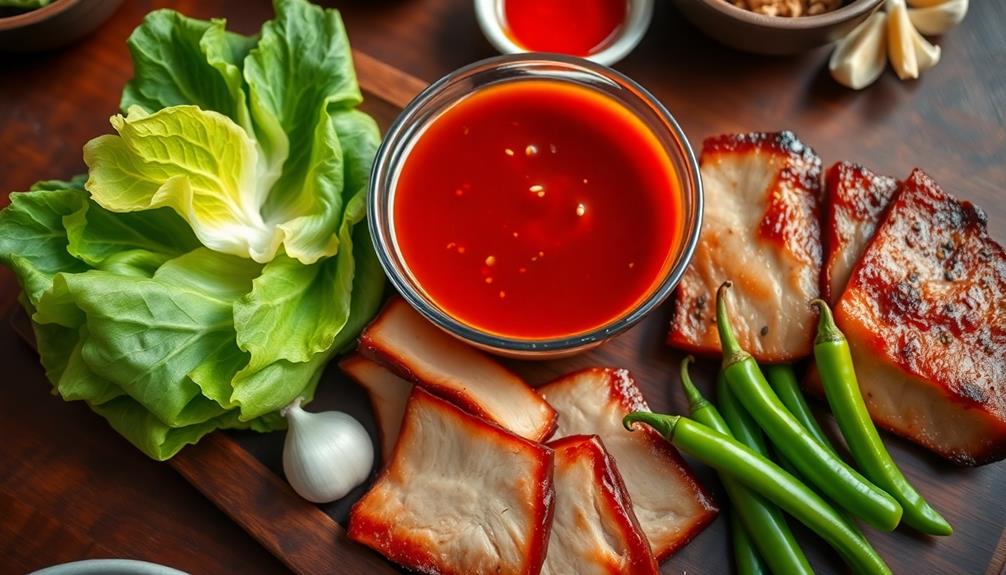
When you're ready to serve your perfectly grilled samgyeopsal, make sure to have some ssamjang sauce on hand. This delicious dipping sauce is a blend of fermented soybean paste and gochujang, adding a flavorful kick that'll make your taste buds dance!
To prepare your ssamjang, simply mix equal parts of these two ingredients in a small bowl. You can also add a bit of minced garlic, sesame oil, or chopped green onions for extra flavor.
Now, grab your crispy pork belly and cut it into bite-sized pieces. You can let everyone take their own pieces, making it fun for everyone at the table!
As you dip the samgyeopsal into the ssamjang, you'll notice how well the rich, salty flavor complements the juicy meat. It's like a party in your mouth!
Don't forget to have extra ssamjang on the side, just in case you want more. And remember, the more you dip, the merrier!
Step 5. Add Fresh Vegetables for Crunch

To elevate your samgyeopsal experience, adding fresh vegetables for crunch is a fantastic idea. Not only do they provide a delightful texture, but they also bring vibrant colors and flavors to your meal.
Start by choosing your favorite crunchy veggies, like lettuce, cucumbers, and radishes. These will be perfect for wrapping around the grilled pork belly or munching on the side.
First, wash your vegetables thoroughly. Then, slice the cucumbers into thin sticks and chop the radishes into bite-sized pieces. For the lettuce, you can tear it into manageable pieces that fit perfectly in your hands.
Now, it's time to get creative! You can mix and match these veggies on your plate, making sure they're ready for your samgyeopsal.
When you're ready to eat, grab a piece of grilled pork belly, place it on a lettuce leaf, and add some cucumber and radish for that satisfying crunch.
Don't forget to dip it in some ssamjang sauce for extra flavor. Trust me, the combination of smoky meat and fresh veggies is simply delicious!
Final Thoughts
Samgyeopsal's rich flavors and communal dining experience make it a standout choice for gatherings. When you grill those thick slices of pork belly, the sizzle fills the air, and everyone can't help but get excited!
You get to cook the meat right in front of your friends or family, which makes it feel like a fun, team effort. Plus, dipping the crispy pork into sesame oil or soybean paste adds a burst of flavor that'll have your taste buds dancing.
Don't forget to load up on fresh veggies! Wrapping the grilled pork in lettuce with a slice of garlic or a dab of spicy sauce makes each bite a delightful surprise.
It's all about sharing and enjoying flavors together, and that's what makes samgyeopsal so special.
Frequently Asked Questions
What Sides Are Traditionally Served With Samgyeopsal?
When enjoying grilled meats, you'll often find sides like pickled vegetables, lettuce wraps, and flavorful sauces. These accompaniments enhance your dining experience, balancing the rich flavors of the main dish and adding freshness.
Can Samgyeopsal Be Made With Other Meats?
Yes, you can use other meats! Chicken, beef, or even lamb can work well. Just marinate them in similar flavors, grill until cooked, and enjoy them with your favorite sides and dipping sauces.
Where Can I Find Authentic Samgyeopsal Restaurants?
You can find authentic restaurants by searching online reviews, asking locals for recommendations, or exploring areas with a vibrant Korean community. Don't forget to check social media for updates on popular spots and hidden gems!
Is Samgyeopsal Suitable for a Low-Carb Diet?
If you're considering a low-carb diet, you'll find that grilled meats can fit well. They're high in protein and healthy fats while being low in carbs, making them a great choice for your meals. One great option for grilled meats on a low-carb diet is a traditional Korean galbi recipe. Galbi, which is marinated beef short ribs, is typically grilled and can be a delicious and satisfying addition to your meal plan. The marinade for galbi usually consists of soy sauce, garlic, and sugar, so making a few simple substitutions can easily turn it into a low-carb option. With the right adjustments, you can enjoy this flavorful dish while sticking to your low-carb goals.
How Can I Store Leftover Samgyeopsal?
To store leftovers, let them cool to room temperature, then wrap them tightly in plastic wrap or aluminum foil. Place the wrapped portions in an airtight container and refrigerate for up to three days.
